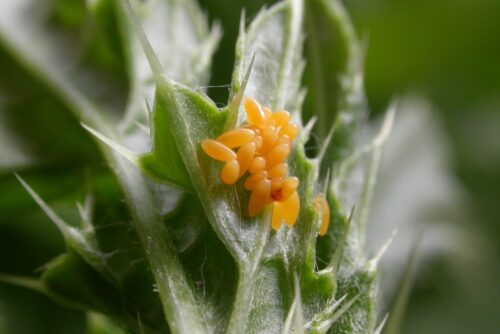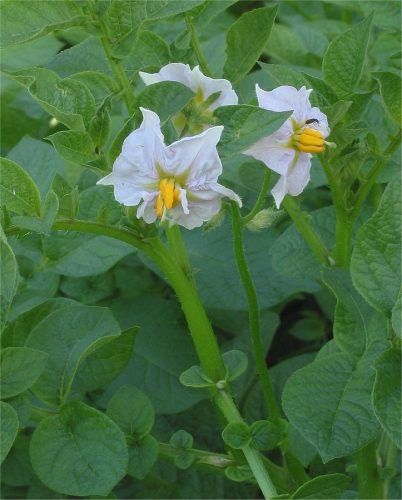The potato is a plant with underground tubers. The potato is the world’s most important food crop after rice, wheat and maize.
You are viewing the mobile-adapted version of the page.
The display for tablets, laptop and desktop also provides general information such as origin, toxicity and cultivation.
The potato (Solanum tuberosum) is a plant with underground tubers. The potato is the world’s most important food crop after rice, wheat and maize.
The potato comes from South America and has been a staple food in Europe since the sixteenth century.
Ridging, raising the soil around the plant (hilling) ensures more root growth and therefore more potatoes is best as soon as the foliage is 20 cm high; keep doing that until the chance of frost has passed. Don’t let the potatoes grow above ground, which will cause them to turn green and develop the toxic solanine . Green potatoes are no longer edible. Cut away the green parts; heating does not destroy solanine.
The potatoes can be harvested as soon as they have finished flowering and the leaves start to droop. Lift a plant and see if the potatoes are already big enough. Harvest as needed in the beginning. Late varieties should also be harvested later; wait with the harvest until the foliage dries up.
Let the potatoes dry in the field for a day or two, or in a shed or garage if it rains. Harvest all potatoes, even the smallest ones; this prevents the formation of new potato plants in the following season, which encourages diseases. Clean up all the potato tops and put this in the green container. Potato leaves cannot go on the compost heap, because they can contain molds and germs.
The storage potatoes can be harvested in September. Do not leave storage potatoes in the ground for too long: snails and slugs will attack them.
In agriculture, crop rotation is mandatory for the cultivation of potatoes – this means that potato blight and Colorado potato beetles have less chance.
Bugs
Growth lags behind: Potato cyst nematode (Globodera rostochiensis).
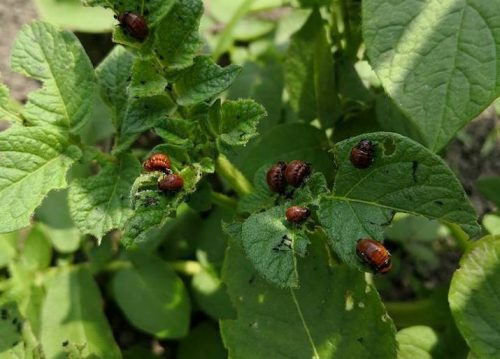
Leaf is eaten away: Colorado potato beetle.
Tunnels and holes in the potatoes: Wireworm, larva of click beetle (Elateridae).
Leaf yellows, withers and dies; roots become bushy and rotten spots develop on the roots: northern root lesion (Pratylenchus penetrans).
Peel cracks and becomes thin and wears like paper: Potato rot nematode (Ditylenchus destructor).
Yellow and brown spots under the skin, blemishes and 2 to 4 mm small deformities at the ends of the roots: Root knot nematode (Meloidogyne fallax).
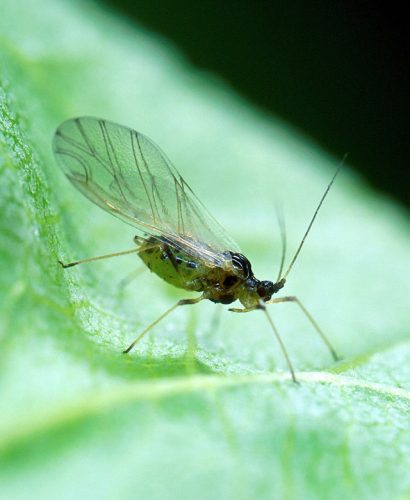
Curled leaves; here and there is an aphid of about 2 mm size: Green peach aphid (Myzus persicae).
Leaf shows holes: Common green capsid (Lygocoris pabulinus).
Leaf turns yellow and bumpy; eggs on the underside of the leaf: Greenhouse whitefly (Trialeurodes vaporariorum).
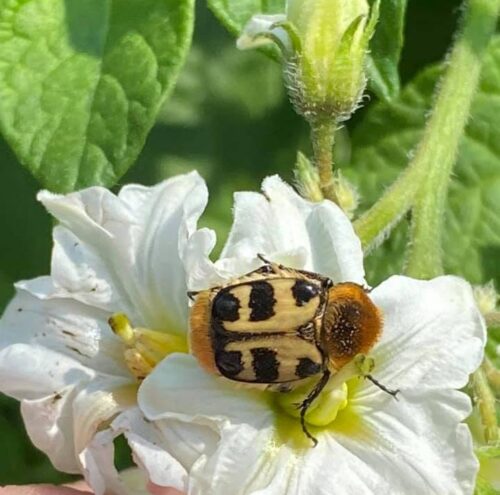
This almost one and a half cm large beetle is an Eurasian bee beetle (Trichius fasciatus). Bee beetles can do no harm, but help with pollination.
Fungi & diseases
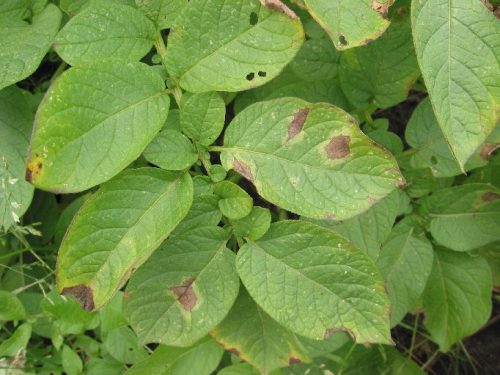
Brown spots on leaves and stems: Phytophthora.

The young leaf rolls up inwards, turns yellow and later purple-brown: Potato leafroll virus (PLRV).
Cancerous brown spots (dry rot) on the potato and on the carrot, later black: Gangrene (Phoma exigua).
Young stems and sprouts are affected, later a white or grey sleeve forms around the stem; black spots on the potato: Black scurf (Rhi
Dying plant parts, later a thick layer of white fungus follows: Sclerotinia disease (Sclerotinia sclerotiorum).
Leaves at the end of a stem wilt, with the leaf not curling or coiling. Then more top leaves follow. A cut infected stem shows bacterial mucus. When harvesting infected potatoes, the soil around the potato is slimy and sticks: Ralstonia solanacearum.

Dark, corky spots with star-shaped cracks develop on the root: Common scab (Streptomyces scabies) .

Small brown spots on the leaf, growing into large spots, after which the leaf yellows, curls and dies: Alternaria leaf blight, caused by a fungus: Alternaria alternata.
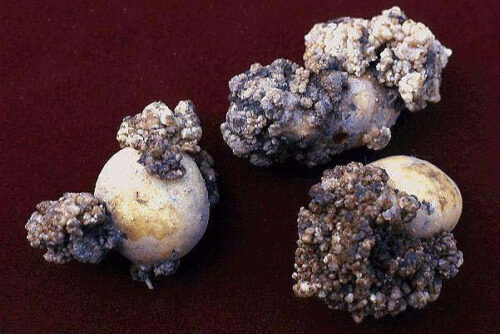
Brownish warts on potatoes: Potato wart disease, caused by the fungus Synchytrium endobioticum.
Other
Retarded growth, plants turn pale, oldest leaves discolour first: Nitrogen deficiency.
Leaves turn dark green, become shiny and turn bronze after which they die: Potassium deficiency.

Large holes in harvested potatoes, usually teeth marks are visible: mice and/or rats. underground voles can also eat holes in potatoes. Like the mole cricket, but no teeth marks can be found in the mole cricket damage.
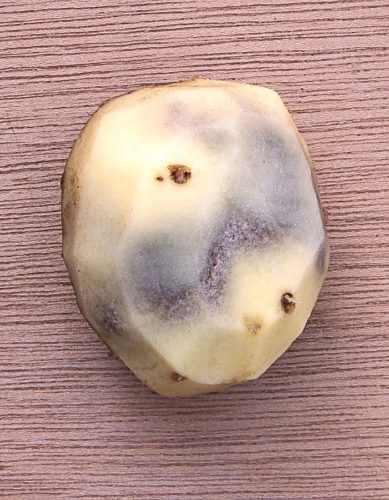
When peeling, it turns out that there are blueish or black discolorations under the skin that have to be cut away: Potato bruising.
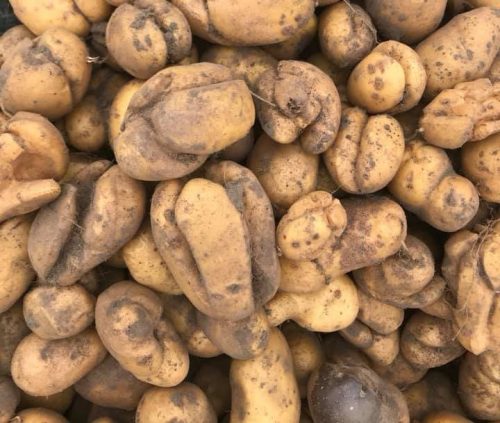
Cracks in the potatoes due to irregular moisture supply. After drought, a period with a lot of rain follows, as a result of which the potatoes have a growth spurt, resulting in growth cracks.
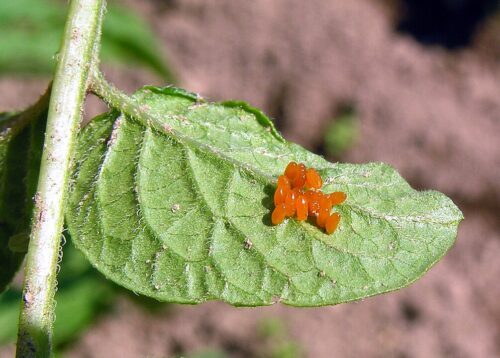
Orange eggs on the underside of the leaf: eggs of the Colorado potato beetle. Destroy these. Note: the eggs are somewhat similar to those of the ladybug; however, these are less bright orange and larger than those of the Colo
